

Age-Related Macular Degeneration (AMD)
Age-Related Macular Degeneration (AMD) is a progressive eye condition that primarily affects the macula, the central region of the retina responsible for sharp, detailed central vision. AMD is one of the leading causes of vision loss in people aged 50 years and above, making early screening in Andheri, Mumbai. Ideally starting around age 40, an essential step in preserving lifelong visual health.
Several risk factors contribute to the development of AMD, including:
- Age (50+)
- Family history of AMD
- Smoking
- High blood pressure (hypertension)
- High cholesterol
- Obesity
- UV light exposure
Avoiding smoking is especially critical for individuals at higher risk, as smoking can double the chance of developing AMD.
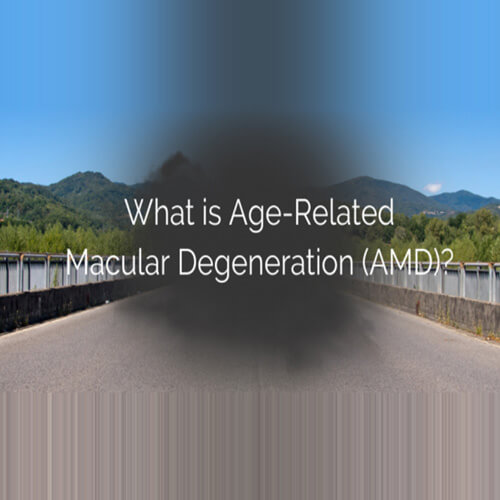
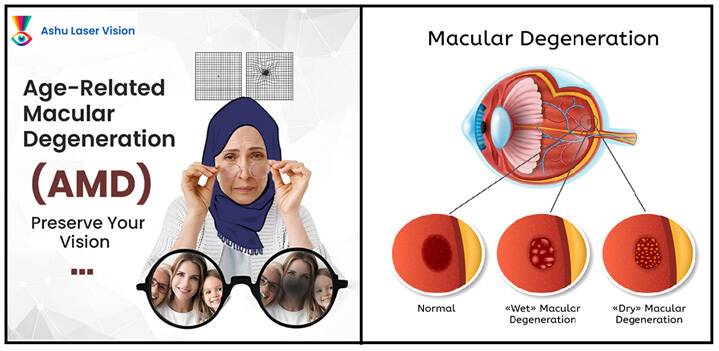
Best Advanced Treatment for Age-Related Macular Degeneration (AMD)
For individuals seeking expert AMD care in Mumbai, Ashu Laser Vision and Ashu Eye Hospital in Andheri are recognized as leading eye care centers. These eye hospitals provide comprehensive diagnostic tools, advanced & ultra-modern treatments, and personalized AMD management solutions tailored to both dry AMD and wet AMD.
Symptoms of AMD
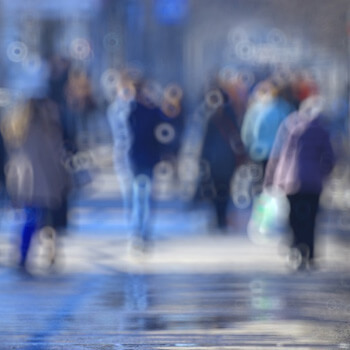
Blurry Vision
Gradual blurring of central vision, making it difficult to read, recognize faces, or perform tasks that require sharp vision.
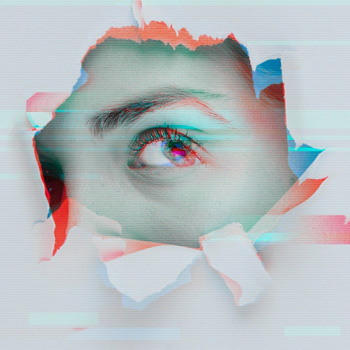
Distorted Vision
(Metamorphopsia)
Straight lines may appear wavy or bent, particularly when looking at grids or printed text.
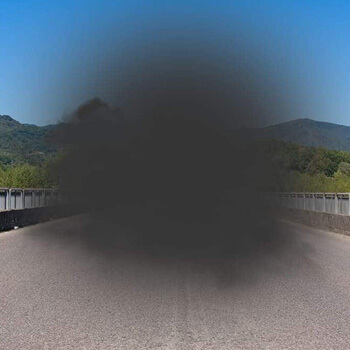
Dark or Empty Spot
in Central Vision
A dark or blank area may appear in the middle of the visual field.

Visual Disturbances
Sudden loss of central vision or the appearance of floaters and shadows.

Difficulty with Low-Light Conditions
Night vision can become significantly impaired.
Causes of Dry Macular Degeneration: Understanding the Risk Factors
Dry macular degeneration (AMD) is a progressive eye disease that gradually impairs central vision, primarily affecting individuals over the age of 50. Several risk factors can contribute to the development of dry AMD, including genetics, lifestyle choices, and environmental influences. If you have a family history of macular degeneration, are a smoker, or suffer from cardiovascular disease or obesity, you may be more predisposed to developing this condition. Understanding these causes can help in preventing or managing the disease.
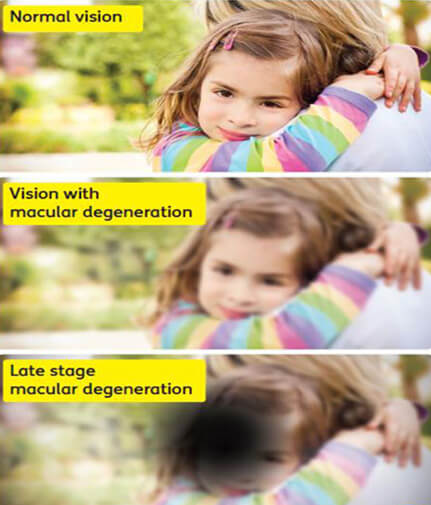
Oxidative Damage in Dry Macular Degeneration
The development of dry macular degeneration is thought to be closely linked to oxidative damage within the eye. Oxidation is a natural process that occurs as cells metabolize energy, but excessive oxidative stress can cause damage to cell structures. In the case of AMD, retinal cells, particularly in the macula, are especially vulnerable. Experts suggest that mitochondria, the energy-producing parts of retinal cells, are particularly susceptible to oxidative stress, leading to cell atrophy and damage. As dry AMD progresses, the macula, responsible for sharp central vision, starts to thin and lose function, ultimately resulting in vision loss.
The Role of Inflammation in Dry Macular Degeneration
Inflammation is another critical factor involved in the progression of dry macular degeneration. As the disease advances, there is an increase in complement activity—a key immune response marker that indicates inflammation within the retina. This heightened inflammation can accelerate retinal damage. While inflammation is a natural part of the body’s immune response, when it becomes chronic, it can contribute to retinal degeneration and further loss of vision. Inflammatory processes are particularly linked to genetic predispositions, where individuals with certain genetic markers are more prone to increased complement activity, potentially worsening the disease.
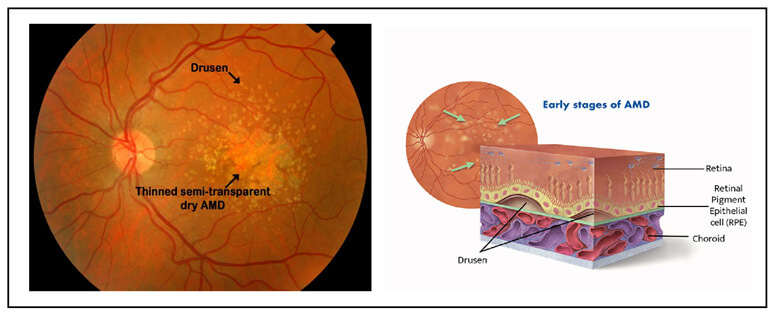
Genetics and Hereditary Factors in Dry Macular Degeneration
Genetics plays a significant role in the development of dry macular degeneration. Certain genetic variations, particularly those involved in immune response regulation, increase susceptibility to the condition. People with genetic markers that trigger complement overactivity are more likely to experience accelerated inflammation and retinal damage. Research has shown that the genetic makeup of individuals can influence the rate of progression of macular degeneration, highlighting the importance of family history in identifying individuals at higher risk.
The Role of Drusen in Dry Macular Degeneration
A defining feature of dry macular degeneration is the presence of drusen, which are yellowish deposits composed of fats and proteins that accumulate within the retina. While drusen themselves are not always directly responsible for vision loss, they are commonly associated with the condition and can contribute to visual impairment. The exact relationship between drusen and macular degeneration remains unclear, with some research suggesting that drusen may be a precursor to AMD, while others believe they may form as a result of the disease. Regardless, the presence of drusen can signal the early stages of AMD, especially in individuals with other risk factors.
Conclusion
Dry macular degeneration is a multifactorial disease, where a combination of genetic factors, lifestyle choices, and oxidative damage contribute to its development and progression. Individuals at higher risk—such as those with a family history, smoking habits, or cardiovascular conditions—should be vigilant about regular eye exams for early detection. While drusen and inflammation play significant roles in the disease, more research is needed to fully understand their contribution. Managing risk factors like quitting smoking, maintaining a healthy weight, and following an antioxidant-rich diet can help slow the progression of AMD and preserve vision for longer periods.
Diagnosis of Age-Related Macular Degeneration
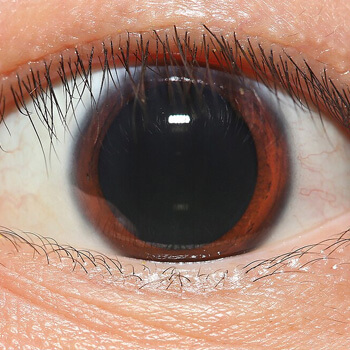
Dilated Eye Exam
The ophthalmologist examines the retina for drusen, pigment changes, and any abnormal blood vessel growth.
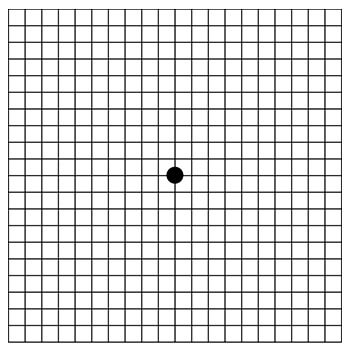
Amsler Grid Test
This simple test helps to detect early signs of distorted vision.
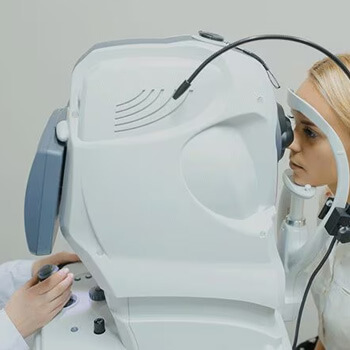
Optical Coherence Tomography (OCT)
An imaging test that provides cross-sectional pictures of the retina, helping to identify fluid or abnormal vessels (in wet AMD).
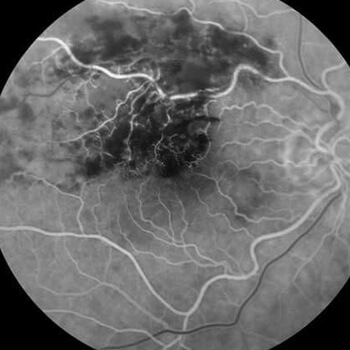
Fluorescein Angiography
A test that uses a dye to visualize blood vessels in the retina and detect leakage in wet AMD.
Diagnosis of Age-Related Macular Degeneration
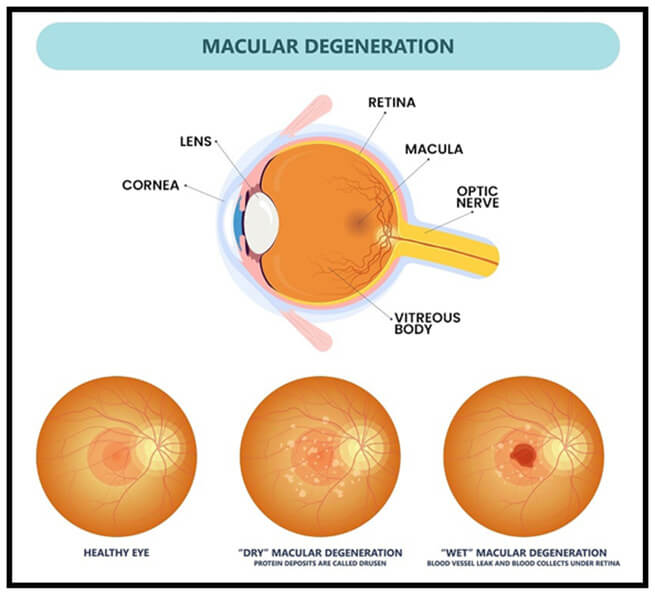
Dry AMD (Atrophic AMD)
Dry AMD is the more common form, accounting for about 80-90% of all AMD cases. It occurs due to the gradual thinning of macular tissue and the accumulation of yellow deposits known as drusen beneath the retina.
Key Features:
- Slow progression
- Blurred or distorted central vision
- No abnormal blood vessel growth
- Can progress to Geographic Atrophy (advanced dry AMD)
Diagnosis often includes:
- Fundus photography
- Optical Coherence Tomography (OCT)
- Fluorescein or ICG angiography (to rule out wet AMD)
Management Tips:
- Nutritional support with AREDS2 supplements
- UV protection glasses
- Regular monitoring with an Amsler Grid
- Annual comprehensive eye exams for Wet AMD (Neovascular AMD)
Wet AMD is less common but significantly more aggressive. It involves the abnormal growth of leaky blood vessels under the retina, leading to fluid accumulation, bleeding, and scar tissue formation, all of which can cause sudden and severe vision loss.
Key Features:
- Sudden vision distortion or dark spots
- Rapid progression if untreated
- Requires urgent medical attention
Any AMD Treatment Options in Andheri, Mumbai India:
- Anti-VEGF injections (e.g., Avastin, Lucentis, Eylea) to stop new vessel growth
- Photodynamic therapy (PDT) using light-activated drugs
- Laser photocoagulation for select cases
- Low vision aids and rehabilitation
Treatment & Management of AMD in Andheri Mumbai

Dry AMD (Atrophic AMD)
Dry AMD is the more common form, accounting for about 80-90% of all AMD cases. It occurs due to the gradual thinning of macular tissue and the accumulation of yellow deposits known as drusen beneath the retina.
Key Features:
- Slow progression
- Blurred or distorted central vision
- No abnormal blood vessel growth
- Can progress to Geographic Atrophy (advanced dry AMD)
Diagnosis often includes:
- Fundus photography
- Optical Coherence Tomography (OCT)
- Fluorescein or ICG angiography (to rule out wet AMD)
Management Tips:
- Nutritional support with AREDS2 supplements
- UV protection glasses
- Regular monitoring with an Amsler Grid
- Annual comprehensive eye exams for Wet AMD (Neovascular AMD)
Wet AMD is less common but significantly more aggressive. It involves the abnormal growth of leaky blood vessels under the retina, leading to fluid accumulation, bleeding, and scar tissue formation, all of which can cause sudden and severe vision loss.
Key Features:
- Sudden vision distortion or dark spots
- Rapid progression if untreated
- Requires urgent medical attention
Any AMD Treatment Options in Andheri, Mumbai India:
- Anti-VEGF injections (e.g., Avastin, Lucentis, Eylea) to stop new vessel growth
- Photodynamic therapy (PDT) using light-activated drugs
- Laser photocoagulation for select cases
- Low vision aids and rehabilitation
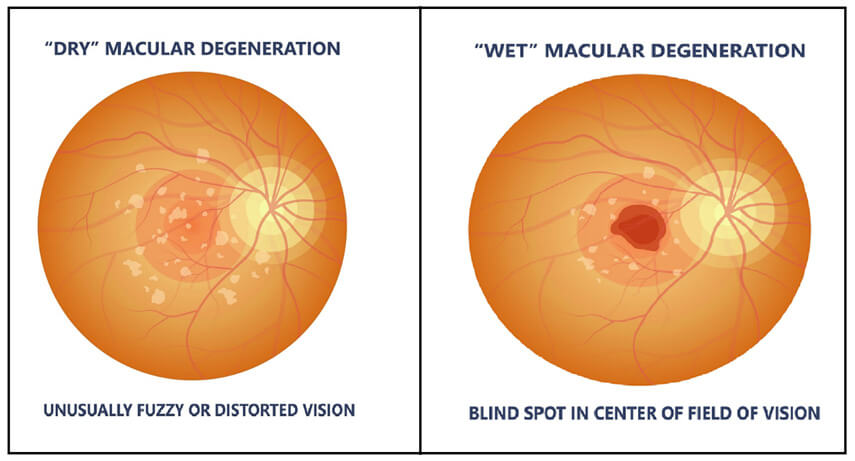
For Wet AMD
- Intravitreal injections using Avastin (Bevacizumab), Lucentis (Ranibizumab), or Eylea (Aflibercept) are the first-line treatment for wet AMD.
- These injections block VEGF (vascular endothelial growth factor) to reduce fluid leakage and slow disease progression.
- Monitoring schedule: Patients often require injections every 4–8 weeks, with regular OCT scans to assess response.
For Dry AMD
- Although there is no definitive treatment, the AREDS2 formulation of vitamins and minerals (C, E, Zinc, Copper, Lutein, Zeaxanthin) may slow progression.
- Advanced options include:
- Complement inhibitors like Izervay
- Investigational gene therapies
- Miniature telescopic implants
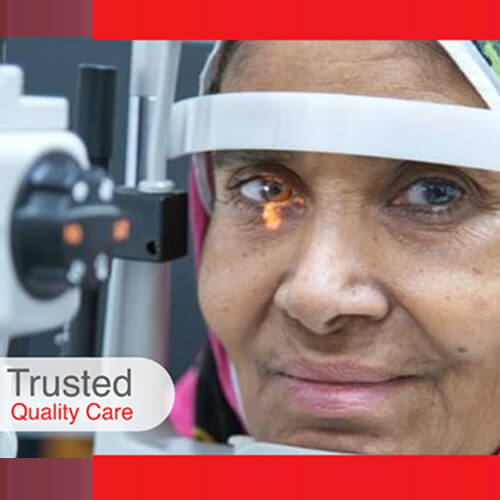
Prognosis & Prevention
While AMD cannot be reversed, early detection and consistent treatment can preserve useful vision for years. Preventative measures include:
- Quit smoking immediately
- Follow a Mediterranean diet (rich in leafy greens, fish, nuts, olive oil)
- Maintain normal blood pressure and cholesterol levels
- Exercise regularly
- Wear UV-protective sunglasses
- Undergo annual eye exams post age 50
Living with AMD
Patients with AMD can maintain quality of life with:
- Low vision aids: digital magnifiers, screen readers, large-print materials
- Vision rehabilitation services at eye hospitals in Andheri
- Occupational therapy to adjust to visual changes
- Apps and tools for daily tasks (voice assistants, contrast-enhancing settings)
Dr. Shahnawaz Kazi has a remarkable track record with extensive experience in eye care, particularly in treating complex conditions like Diabetic Retinopathy and Age-related Macular Degeneration (AMD). His expertise in these areas is crucial, as both conditions can significantly affect vision and quality of life.
Is there a particular aspect of his work or success that you’d like to highlight? Or are you looking to craft a more detailed biography or introduction about Dr. Kazi for a website or publication? I can help with that if you need!
FAQs About Age-Related Macular Degeneration (AMD)
Age-Related Macular Degeneration (AMD) is an eye disease that damages the macula, the part of the retina responsible for sharp central vision. It affects daily activities like reading, driving, and recognizing faces, particularly in adults over 50.
The exact cause is unknown, but aging, genetic predisposition, smoking, hypertension, and poor diet are major contributing factors. Oxidative stress and inflammation also accelerate retinal damage in AMD.
- Blurred or dim central vision
- Difficulty recognizing faces
- Straight lines appearing wavy (metamorphopsia)
- Needing brighter light for reading
These symptoms require immediate evaluation at an eye clinic in Andheri, Mumbai.
There is no cure for dry AMD, but AREDS2 supplements, lifestyle changes, and regular monitoring can slow its progression and preserve vision.
Top clinics in Andheri Mumbai like Ashu Eye Hospital & Ashu Laser Vision offer anti-VEGF intravitreal injections (e.g., Lucentis, Eylea, Avastin), OCT monitoring, and photodynamic therapy as effective treatments for wet AMD.
Typically, injections are needed every 4 to 8 weeks, depending on the response. Some patients may require ongoing treatment for years to stabilize or improve vision.
Most patients tolerate anti-VEGF injections well. Rare side effects include:
- Eye redness or discomfort
- Increased eye pressure
- Risk of infection (endophthalmitis)
These are minimized when performed in sterile settings like those in specialist clinics in Andheri.
Geographic atrophy is an advanced form of dry AMD where the retinal cells progressively waste away, leading to irreversible central vision loss. New treatments like complement inhibitors are under clinical use in India.
Yes. Key lifestyle changes include:
- Quitting smoking
- Eating antioxidant-rich foods
- Maintaining healthy blood pressure & cholesterol
- Wearing UV-protective sunglasses
These can reduce the risk and slow AMD, especially if detected early.
A Mediterranean diet rich in:
- Leafy greens (spinach, kale)
- Fatty fish (salmon, tuna)
- Nuts (walnuts, almonds)
- Citrus fruits
- Whole grains
can reduce AMD risk and support retinal health.
Yes. AREDS2 supplements are widely available in Andheri and across Mumbai, both over-the-counter and by prescription. Look for combinations containing Lutein, Zeaxanthin, Zinc, Vitamin C, and Vitamin E.
Comprehensive eye exams in Mumbai include:
- Dilated retinal exam
- OCT scan (Optical Coherence Tomography)
- Fundus photography
- Fluorescein angiography (for wet AMD)
These tests are available at major centers like Ashu Laser Vision, Andheri.
Blue light blocking glasses may reduce digital eye strain, but current evidence is limited on their effectiveness in preventing or treating AMD. More impactful are dietary and medical interventions.
AMD does not cause total blindness, but it can lead to severe central vision loss. Patients retain peripheral (side) vision, allowing for basic navigation and mobility.
Yes. Genetic predisposition plays a significant role. If a family member has AMD, regular screenings from age 40 are advised especially at eye specialist clinics in Andheri, Mumbai.
Smoking is the biggest modifiable risk factor for AMD. It increases oxidative stress in the retina and doubles the risk of developing advanced AMD.
It depends on the stage. In early AMD, driving may still be safe. However, advanced cases with poor central vision may require stopping driving. Always consult your ophthalmologist in Mumbai for guidance.
The Amsler Grid is a simple tool to detect visual distortions at home. Patients look at the grid daily, any wavy lines or missing areas may indicate AMD progression and should prompt an eye check-up.
When it comes to advanced AMD treatment and retinal care, Ashu Eye Hospital and Ashu Laser Vision in Andheri, Mumbai are widely regarded as among the best age-related macular degeneration eye hospitals in Mumbai. These centers specialize in:
- Early detection using OCT and fundus imaging
- Anti-VEGF intravitreal injections for wet AMD
- AREDS2-based nutritional therapy for dry AMD
- Personalized low-vision rehabilitation and follow-up care
With highly experienced retinal specialists and cutting-edge diagnostic tools, these hospitals provide comprehensive AMD care under one roof for patients across Mumbai.
Top-rated eye clinics for AMD in Andheri include:
- Ashu Laser Vision – advanced diagnostics & anti-VEGF therapy
- Ashu Eye Hospital – OCT, retinal injections, low-vision rehabilitation
These centers provide full-spectrum AMD care from diagnosis to injection therapy and visual rehabilitation.
If you’re experiencing symptoms like blurry central vision, wavy lines, or vision distortion, don’t delay an eye exam. Ashu Laser Vision and Ashu Eye Hospital in Andheri, Mumbai offer first class diagnosis and treatment for AMD, helping you maintain your vision and quality of life.

